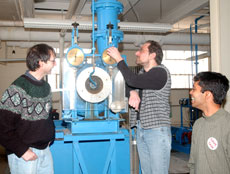Old experiment yields new uses

Amelia Moore
February 14, 2006
More than 70 years ago, a groundbreaking experiment was performed in physics that dealt with fluid turbulence. Once interpreted, the results would answer the last great remaining question of classical physics. University professors Gustavo Gioia, Nigel Goldenfeld and graduate student Pinaki Chakraborty, are on the verge of answering that question.
The experiment was performed by Johann Nikuradse and published in Germany in 1933. Nikuradse measured the friction a fluid experiences as it is forced through a pipe at varying speeds, where the flow in the pipe is turbulent. He found that the friction decreases as the speed increases, but then the friction increases at high speeds before attaining a constant value.
“This surprising behavior has never been explained theoretically before,” Gioia said. “Oil and natural gas are transported at great distances through pipelines, at speeds comparable to those tested by Nikuradse. In these pipelines, the cost of pumping is proportional to the friction. Understanding and controlling the friction could save millions of dollars a year.”
The results from this experiment concern numerous fields of science, Goldenfeld said.
“It is not a matter of pipes only; pipes are a convenient setup to measure fluid friction in the lab,” Goldenfeld said. “The kind of behavior measured in pipes has also been measured in open-channels, and that is the reason why our work is relevant to hydraulics engineering, hydrology, geomorphology and other disciplines that deal with rivers and flood plains, which are rough open channels.”
Get The Daily Illini in your inbox!
The professors said the result of their research has implications on many fields in today’s society.
“Our work is also relevant to turbulent flows over all sorts of rough surfaces – the surface of a submarine, the wings of an airplane, the skin of a shark, the corn fields being swept by the wind around Urbana,” Gioia said. “Most of the flows that surround us in everyday life are turbulent flows on rough surfaces.”
Gioia and Chakraborty have been working on research papers documenting the theoretical explanation behind the behavior measured.
“Our explanation is based on conceptual model of turbulence that goes back to Leonardo Da Vinci, who pictured fluid turbulence as made up of locally swirling motions of many different sizes, all jumbled up,” Gioia said.
The novelty in the work is that they found a way of identifying the swirling motions that are most critical in producing friction.
“The results will make it possible for engineers to calculate the friction from first principles, instead of having to rely on a chart or table,” Gioia said.
Goldenfeld’s work provides a long-sought-after link between turbulence and a class of phenomena, known as phase transitions, whose elucidation was one of the great sagas of 20th century physics.
Among other things, Goldenfeld’s work implies that a turbulent flow in a smooth pipe cannot be understood except as the turbulent flow in a rough pipe of extremely low roughness – a crucial fact that may be discerned, in retrospect, in Gioia and Chakraborty’s work.
“My results suggest that the powerful mathematical methods that led to the elucidation of phase transitions may now find a new application in turbulence, the last major unsolved problem in classical physics,” Goldenfeld said.






